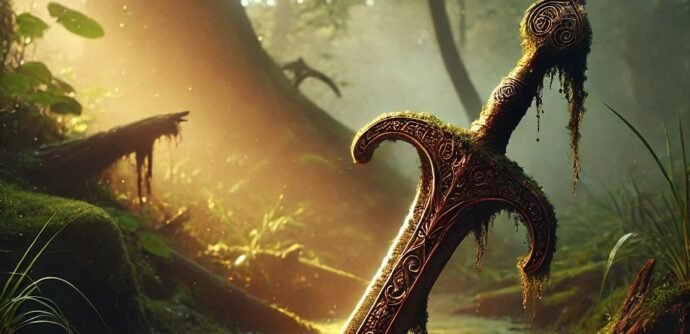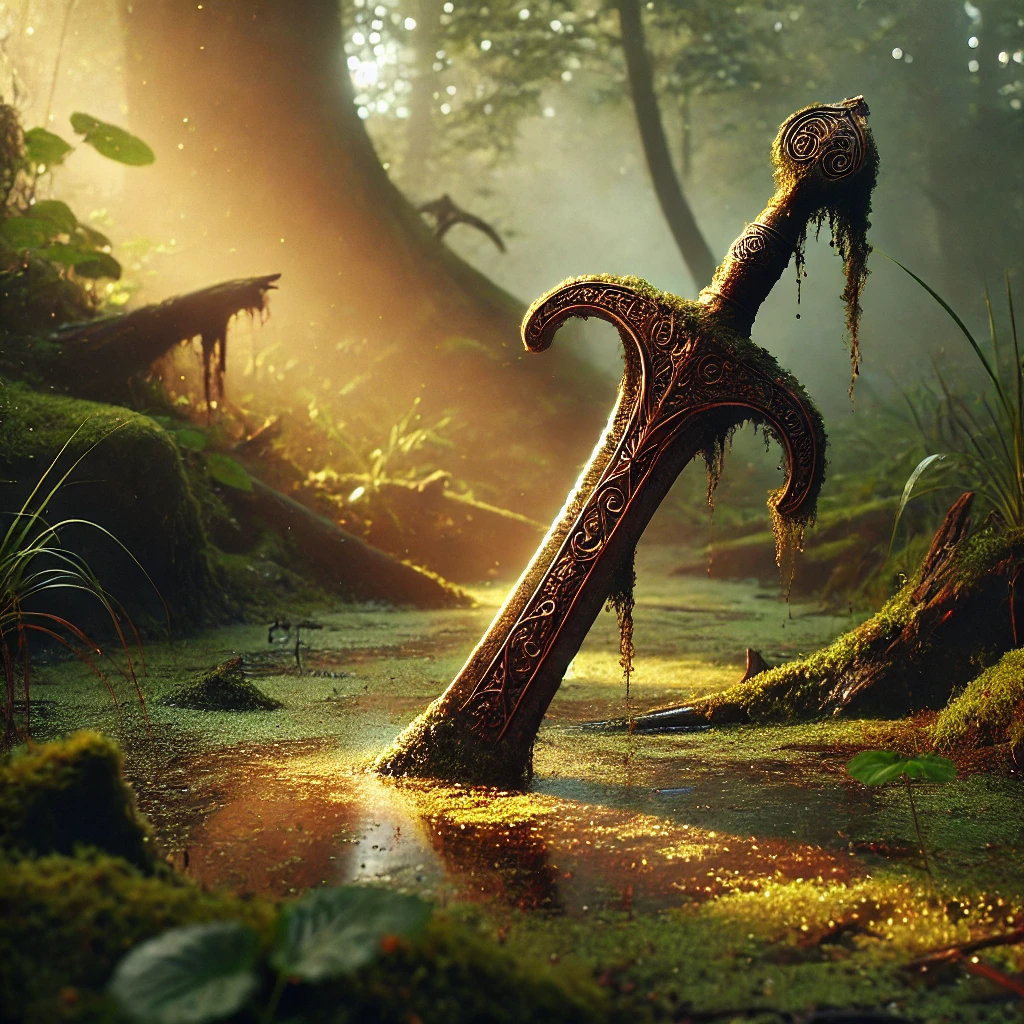Introduction The sword has been one of the most ancient and influential weapons of human civilization. In all civilizations that developed in history—whether in India, Europe, China, Japan or the Middle East—swords were not only a means of war but also a symbol of religious, cultural and political power. Particularly curved swords, such as the Indian Talwar, Samurai Katana and Scimitar, have been weapons in history that have deeply influenced the world.
In 2025, a discovery in the Værebro Indal region of Denmark again drew the attention of historians to this direction. Here a Bent Sword was found which is believed to be from 500 BC. This sword is from the transition period between the Bronze Age and the Iron Age and it was offered as a ritual sacrifice in the bog. This discovery adds a unique chapter to Bent Sword History because it proves that swords were not only made for war, but also for spiritual and religious purposes.
Today, when we study Curved Sword History, we get a chance to understand how swords were the central point in the development of human civilization, warfare, religion and politics.
Discovery and Archaeological Importance of the Sword
This Bent Sword from Denmark is not just an old metal, but a window showing a deep glimpse of history. It was discovered by a metal detectorist and archaeologists found on investigation that this sword was deliberately bent. Doing this was not an ordinary act, but it was a symbol of sacrifice and ritual. Ancient people believed that when a warrior offers his sword to the gods, it should be deactivated, so that it cannot be used in war again.
This discovery shows that during the Bronze Age and Iron Age, swords were not just a means of war, but they were also a part of religion and culture. This sword found in the bog shows that warriors used to offer their most valuable weapon as a form of devotion and sacrifice to the gods.
The study of Bent Sword History also makes us understand that apart from Europe, such traditions also existed in Asia, India and Japan. For example, Talwar in India, Katana in Japan and Scimitar in the Middle East were dedicated to gods or rulers on special occasions.
Archaeologists believe that such discoveries help us understand that Curved Sword History is not only a war technique but also a part of social and religious structure. This is why even today these swords are considered highly valuable in museum collections and antique swords for sale market.
Swords and Ancient Warfare

In every era of history, war was not only a display of power, but also a game of strategy, courage and weapons. The most important weapon among these has been the sword. Swords played an important role not only in the battlefield but also in the creation of civilizations. When we look at Curved Sword History, it is clearly understood that curved swords like Indian Talwar, Samurai Katana and Scimitar were much more effective than straight swords in war conditions.
1 Use in war
Ancient Greek warriors used swords like xiphos, while the basis of power of the Roman Empire was gladius. Curved swords like scimitar in the Middle East and talwar in India gave amazing strength to the cavalry. During horse riding, curved swords were helpful in cutting the enemy easily and making the next move immediately. This is why Mongol invaders and Turk warriors used curved swords more.
Rajput and Maratha warriors of India did not consider Talwar only as a means of war, but considered it a symbol of bravery and prestige. At the same time, the Samurai warriors of Japan considered Katana to be a part of their soul. This is the reason why even today the Samurai Katana Sword has not only historical but spiritual importance.
2 Development and Change of Swords
If we look at the development of swords, the swords made in the Bronze Age were small but sharp. In the Iron Age, strong and durable iron swords came, which changed the definition of war. In the Medieval Age, swords became long and heavy, which warriors used to defeat armored enemies. At this time both the European longsword and the Indian talwar became famous.
Bent Sword History tells that many times after the war, swords were bent and offered to the gods as a sacrifice. This proves that swords were not only weapons, but they also had a deep religious and spiritual aspect.
Even today this tradition comes in front of us when we see museum collections, historical books and antique swords for sale. These swords remind us that every war, every empire and every culture in human history is incomplete without swords.
Swords and Religious Traditions

The importance of swords was not limited to war only, but they also made a deep place in religious and spiritual life. When we study Curved Sword History, we find that different civilizations accepted swords not only as a weapon but also as a sacred symbol. Be it India, Japan or Europe—swords have been a part of religious beliefs and rituals everywhere.
1 Spiritual Importance of Swords
In Indian culture, the sword (Talwar) has been considered as one of the weapons of Goddess Durga. This is the reason why Rajput Talwar was worshipped with respect and faith. In Sikhism, Kirpan is not only a means of defense, but a symbol of religious duty and courage.
In Japan, Samurai Katana Sword was called not just a weapon, but the soul of the warrior. Samurai warriors believed that their Katana is a reflection of their loyalty and soul. This is why even today the Katana is considered a sacred heritage in Japanese culture.
In the Middle East and Europe, the Scimitar Sword became a symbol of religious and cultural power. Arab and Turk warriors used it not only in war but also in religious processions and ceremonies.
2 Sacrifice and offering of swords
Bent Sword History tells that in both Europe and Asia there was a tradition in which warriors dedicated their swords as a sacrifice to the gods. Often after the battle, the sword was bent and thrown into a river or bog. This meant that this sword was no longer used in any worldly war, but only in the service of the gods.
In ancient India too, there was a tradition of kings offering their swords to temples after victory. The same tradition is seen in Europe as well, where swords were kept in churches or religious places. In Japan, samurai used to offer their katana to Shinto temples.
👉 This proves that swords were not just a tool for war, but they were a part of religion, spirituality and faith of society. This is why even today they have a special place in museum collections, antique sword auctions and religious exhibitions around the world.
Swords and Politics

Swords were not only a means of war, but were also seen as a symbol of politics and power. If seen in history, the importance of Curved Sword History i.e. curved swords has been very special. Such swords not only helped in making sharp attacks in battle, but were also considered a symbol of power and bravery. This is the reason why many rulers used special types of swords to show their power.
In India, Indian Talwar played a big role in politics and empire building. During the times of the Mughals and Rajputs, this sword was considered the pride of not only the soldiers but also the courts of kings. Similarly, in Japan, the Samurai Katana sword was not only a weapon but a symbol of honor and soul. For the Samurai warriors, this sword was their identity, which also reflected their status in politics.
The importance of Scimitar Sword was very big in the history of Arabia and the Middle East. These curved swords strengthened the military strategies and political dominance of the Islamic empires. Not only this, swords were the basis of power and empire expansion in Europe’s Medieval Weapons.
Even today these swords are important. History lovers and collectors keep searching for them. Antique Swords for Sale can be seen at many places, and big Museum Swords are still a witness to the fact that swords are not just for war but are also a heritage of politics and culture.
Swords and Politics
Swords were not only a tool of war, but also became a symbol of power, politics and culture. When we look at Curved Sword History or Bent Sword History, it is clear that the design and shape of swords became a symbol of the power of the rulers and their rule.
In the Indian subcontinent, the Indian Talwar got a status of prestige and respect not only in war, but also in political ceremonies and royal events. On the other hand, in Japan, the Samurai Katana became a symbol of the character, loyalty and moral values of a warrior. Similarly, in the Middle East, the Scimitar Sword was considered a symbol of political power and religious pride.
Swords: Symbol of Power and Rule
In medieval times, rulers gave special importance to swords in their courts and armies. Many Medieval Weapons were made not only for firepower, but also to show the prestige and dominance of the rulers. Many times, gold and silver carvings were done on the swords and precious gems were studded on them, which further increased their political importance.
Modern Collection and Heritage
Even today, the importance of these historical swords has not diminished. Many Antique Swords for Sale are a center of attraction for collectors around the world. Museum Swords displayed in museums give history lovers and researchers an opportunity to understand how swords have influenced the flow of politics, power and culture.
Relevance of Swords in the Modern Era

Conclusion
The sword has not been just a weapon, but it has been an integral part of human civilization, war, politics and culture. Be it the dagger of Indian warriors, the long swords of European knights or the katana of Japanese samurai—every sword tells the story of its time and society. Swords have been a symbol of strength, courage, honor and power. Even though swords are not used in war today, they will always live on as an immortal symbol of history, tradition and bravery.
❓ FAQs (Frequently Asked Questions)
Q1. Which is the oldest sword in the world?
👉 The oldest sword in the world is considered to be “Arslan Tash Sword”, which is about 5000 years old.
Q2. Which is the most famous sword of India?
👉 The most famous sword of India is considered to be “Bhawani Sword of Shivaji Maharaj”.
Q3. Why is the Japanese sword (Katana) famous?
👉 Katana is counted among the most famous swords in the world due to its sharpness, strength and the bravery tradition of the Samurai.
Q4. Were swords used only for war?
👉 No, swords were used not only for war but also for power, honour and religious ceremonies.
Q5. Where can swords be seen today?
Today swords can be seen in museums, historical sites and treasures of royal families.



